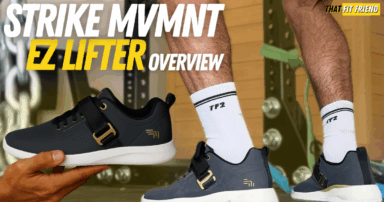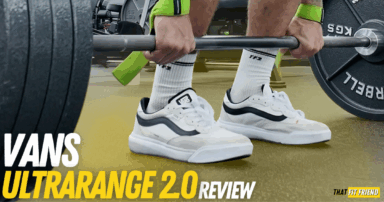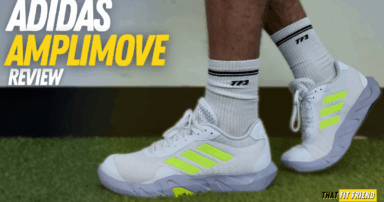That Fit Friend is supported by its readers. I [Jake Boly] run this site myself and buy the gear I review. If you purchase through my site, I may earn commissions on sales, read more here!
The Reebok Nanoflex V2 is a training shoe designed to deliver a versatile performance for a budget-friendly price. This model is the second iteration in the popular Reebok Nanoflex training shoe line.
As a fan of the Reebok Nanoflex TR, I was super excited to put the Nanoflex V2 to the test. I wanted to know how this model would compare to other Reebok cross-training shoes like the Reebok Nano X2.
After multiple tests and sessions in the gym, I have to say I’m a fan of the Reebok Nanoflex V2. This shoe performed exceptionally well compared to other top cross-training shoes on the market.
Reebok Nanoflex V2 Summary
The Reebok Nanoflex V2 is a strong training shoe for anyone looking into models that cost less than $100 USD. This shoe’s performance has been exceptional across the board, and its durability feels pretty solid.
Compared to its predecessor, the Reebok Nanoflex TR, the Nanoflex V2 has received a few key positive construction upgrades. For example, this model’s last feels reworked, so it’s more comfortable, it has better upper construction, and its outsole and midsole feel stronger.
If you like to vary your training on a weekly basis and need a shoe that can do a little bit of everything without breaking the bank, I think the Reebok Nanoflex V2 is a good training shoe to explore.
Now, is this going to be your best training shoe for maxing out your barbell lifts or for serious weekly CrossFit workouts? No, but for its price, it can hold its own, and it’s pretty comparable to the Reebok Nano X2, which costs $45 USD more.
Reebok Nanoflex V2 Pros
Over the span of my testing and reviewing process with the Reebok Nanoflex V2, I’ve found multiple pros and things to like with this shoe.
- Really Good Price Point for This Shoe
- Well-Rounded Performance In the Gym
- Meta-Split Outsole Construction and Better Durability
The first thing to like about the Reebok Nanoflex V2 is its price point. It can be seriously tough to find cross-training shoes that deliver good performance and durability for budget-friendly price points.
The Nanoflex V2 comes in at $90 USD, which is pretty fair for what this shoe offers. I also like that Reebok didn’t increase the price of this model like they did for the Reebok Nano X1, Nano X2, and Nano X2 Adventure.
The second aspect to like about the Reebok Nanoflex V2 is that it delivers a well-rounded performance. Honestly, I’m always excited when I test shoes that have budget-friendly price points and can also hold their own in the gym.
If you’re someone who likes to vary their training every week and do things like taking classes, doing strength workouts, tackling some short runs, and even doing a CrossFit class here and there, the Nanoflex V2 can be worth exploring.
Despite having fewer bells and whistles compared to other “premium” cross-training shoes, I thought the Reebok Nanoflex V2 held its own. It was stable enough for deadlifts up 455 lbs, and it felt lightweight and maneuverable for plyometrics and multi-directional exercises.
The final thing to like about the Reebok Nanoflex V2 is some of the construction updates this model has received. This shoe features meta-split tech on its outsole. This is a feature that the Reebok Nano X and 9 both used, and it helps give this model more mobility.
I also like the reworked upper construction and rubber outsole tread patterning in this model. The upper in this shoe does a good job with foot security, and the lug tread patterning on this shoe has a nice level of traction on different surfaces.
The final notable construction improvement of this shoe is its last construction and Ortholite insole. One of the main gripes that came with the Reebok Nanoflex TR was its comfort. In the Nanoflex V2, it seems Reebok has widened the midfoot and used a more comfortable insole for all-day way.
Reebok Nanoflex V2 Cons
Across the board, I’ve thought the performance of the Reebok Nanoflex V2 has been strong for its price point. However, there are a couple of cons to note with this shoe.
- Performance Is Capped for Specific Training
- Lateral Toe Box Could Use a More Rigid Toe Guard
The first drawback with the Reebok Nanoflex V2 is that its performance will be capped as you get more specific with your training. It’s a good all-around-style training shoe, but if you want a shoe for barbell training or CrossFit, you’ll want to explore different models.
For example, this shoe is not the most stable cross-training shoe on the market. If you’re working on your top-end barbell squat or deadlift strength, you’ll likely be better suited to find a model more specific to this training context.
Additionally, this shoe works for casual CrossFit workouts here and there, but the long-term durability of this shoe in this training context will pail in comparison to a shoe that is built specifically for CrossFit.
My second drawback with the Nanoflex V2 is that I wish the lateral toe box had a more aggressive toe guard. This shoe’s construction is a step in a really good direction for the Reebok Nanoflex shoe line, but this is one small area where this shoe could be improved.
The toe box is pretty good when it comes to security. However, I did notice during some of my single-leg plyometric work that my toes were pushing into this area of the toe box. Without the toe guard, I was noticing a little bit of foot overhang.
It’s important to note that this wasn’t the biggest deal, and it only happened in specific exercises. Yet, it’s still worth noting because the Nanoflex V2 would be a seriously strong, budget-friendly training shoe with this construction tweak.
Performance
To break down my performance assessment of the Reebok Nanoflex V2, I will discuss how this shoe performs in different training contexts. I’ll discuss the Nanoflex V2’s performance for lifting, versatile training, short runs, and daily wear.
This way, you can cross-reference this shoe’s performance and see if it fits your weekly training needs well before investing. If you have additional performance questions, always feel free to reach out.
Testing the Reebok Nanoflex V2 for Lifting
In the context of lifting, the Reebok Nanoflex V2 did a pretty good job throughout my test. This training shoe will work well for anyone wanting a model for more general strength work in the form of barbell, dumbbell, kettlebell, and machine work.
This shoe’s midsole provided adequate stability when working up to around 455 lbs in deadlifts and around 335 lbs in squats. I’d rank their stability as being comparable to the Reebok Nano X2 but with a slightly less firm feel.
I think if you’re investing in this shoe and plan to use it for general strength work, you’ll enjoy their performance for their price point. Honestly, this has been one of the stronger budget-friendly training shoes that I’ve used lately for lifting.
I also enjoy the meta-split construction in this shoe’s outsole and how it performed for some of my high-velocity sessions. If you have an athletic-focused training bias, this could be a good option to consider.
For CrossFit and CrossFit-style training, this shoe did an okay job. I think this model actually has better rope climbing support compared to the Reebok Nano X1 and Reebok Nano X2, and it can hold its own in most casual CrossFit settings.
Will it be the most stable or durable shoe for serious CrossFit-specific training? No, but if you’re doing a class or two a week, this shoe should suffice, especially if you’re trying to save money.
Testing the Reebok Nanoflex V2 for Versatile Training
For versatile training, I’ve enjoyed the performance of the Reebok Nanoflex V2 for three key reasons. First, the midsole in this model does a fairly good job of providing you with a lightweight and responsive ride.
This shoe feels a bit more maneuverable throughout its sole compared to the Reebok Nano X2, and it articulated pretty well for my dynamic training sessions. I like how well the forefoot was able to bend, move, and grip the floor when moving explosively.
Second, I enjoy the upper construction in this model. The upper in this shoe does a fairly good job at promoting full foot security when doing different exercises, especially when tackling plyometrics and multi-directional exercises.
The Nanoflex V2’s upper outperforms other budget-friendly training shoes like the Nike MC Trainer 2 and Nike Legend Essential 2. Plus, it feels a bit more durable with its mesh and textile components. My only gripe with the Nanoflex V2’s upper is I wish the toe box had a better toe guard.
The third reason why I’ve enjoyed the Nanoflex V2 for versatile training is for its outsole construction. This shoe features a full rubber outsole that wraps over the toe box, and it has a lug tread patterning.
Unlike other budget-friendly training shoes that have exposed foam on the bottom of the shoe, the Nanoflex V2’s outsole does a good job of giving you added durability and traction on surfaces like turf and concrete.
Testing the Reebok Nanoflex V2 for Short Runs and Daily Wear
For running, I was surprised at how much I didn’t mind this shoe for some of my shorter runs. When running 2-miles in this model, I didn’t find them to be overly uncomfortable, which is pretty unique for a training shoe in this category.
Now, I wouldn’t run more than 2-3 miles in this shoe, so if you want them for a couple of pre or post-workout miles, they should work well. For sprints and tempo runs, I also thought this shoe did a pretty good job.
They’re lightweight and have an outsole that provides decent traction on different running surfaces like concrete, treadmill tracks, and turf. Plus, the midsole feels pretty responsive for faster-paced runs. I enjoyed them when doing 60-meter pickups.
For daily wear, I also enjoyed the performance of the Nanoflex V2. This shoe is far more comfortable than the Reebok Nanoflex TR for two reasons. First, it feels as though Reebok reworked the last of this shoe, and it no longer constricts the forefoot and midfoot.
Second, this model features a thicker built-in Ortholite insole which gives you additional padding and comfort when you’re on your feet all day. I’ve worn these for 20,000 step days, and they felt pretty comfortable overall, and their price is nice for reducing the guilt of beating up my trainers.
Reebok Nanoflex V2 Vs Reebok Speed 22 TR
I’ve talked a lot in this review about the Nanoflex V2’s performance compared to the Nano X2, but I haven’t mentioned much about the Reebok Speed 22 TR.
The Speed 22 TR is a Reebok training shoe with a comparable price point to the Nanoflex V2, so I wanted to compare them below. Unlike the Nanoflex V2, the Speed 22 TR is designed to be a little more niche for HIIT training.
If you’re considering these two shoes, I wanted to provide a few quick thoughts to help you make up your mind on which shoe to go for. There are two main construction and performance differences that I think are worth noting with these shoes.
The first difference between the Nanoflex V2 and Speed 22 TR is their midsole constructions. The Nanoflex V2’s midsole has a higher density, so it compressed a lot less easily than the Speed 22 TR.
If you want more cushion in your shoes and a model for classes, HIIT, and daily wear, you’ll want to explore the Speed 22 TR as it will match your cushion wants better. The Nanoflex V2’s midsole will be best for those who plan also to lift and cross-train fairly hard in their shoes.
The second difference is the upper and outsole constructions of these models. The Reebok Speed 22 TR features a breathable mesh upper and full rubber outsole wrap. In the Speed 22 TR, the outsole is designed to give you additional medial midfoot support and traction.
In the Nanoflex V2, you have a mesh and textile upper with layers that cover general high-abrasion areas. You also have an outsole that wraps over the toe box and extends up the midfoot for durability and rope climbing support.
In terms of long-term durability, the Reebok Nanoflex V2 feels like it has the edge over these models due to their more reinforced upper and outsole.
Winner: Opt for the Reebok Nanoflex V2 if you’re unsure which model to go with. It will be a stronger performer when it comes to varied weekly training. If you know you want a shoe primarily for HIIT with more cushion, opt for the Reebok Speed 22 TR.

Reebok Nanoflex V2

Reebok Speed 22 TR
Reebok Nanoflex V2 Sizing
Most lifters and athletes should be safe going true to size in the Reebok Nanoflex V2. This shoe’s length fits true, and it has a width that I would describe as neutral.
If you’re a fan of the Reebok Nano cross-training shoe line, this model’s fit feels similar to something like the Reebok Nano 9. The mesh upper has a good amount of volume even with the Ortholite insole.
Note, if you have wide feet, then you may want to size up a half size. However, for most, true to size will be the call in this Reebok Nanoflex V2.
- Reebok Nanoflex V2 Sizing Thoughts: Go true to size.
If you have additional questions on the Reebok Nanoflex V2’s sizing and fit or how it compares to other models, drop a comment below.
Price Breakdown
For the Reebok Nanoflex V2, you can expect to pay $90 USD. Honestly, I’m a pretty big fan of this price point for this shoe and what it has to offer construction and performance-wise.
I feel like if you’re looking for a good all-around training shoe for less than $100 USD, then the Nanoflex V2 can be a strong option to consider.
For example, it has a couple of construction details that somewhat make it better for CrossFit than the Reebok Nano X2.
If you’re trying to save, I don’t think you can go wrong with the Reebok Nanoflex V2. Now, it’s worth noting that serious CrossFit and barbell athletes may want to explore better options that match their niche performance needs a little better.
Construction Details
There have been multiple positive construction updates made to the Reebok Nanoflex V2 compared to the Nanoflex TR. Below are some of the most important construction details to note about this shoe.
- Heel-to-Toe Drop: 7mm
- Weight: 11.80 oz (for my size 10 model)
- Removable Insole: Not technically, but it’s easily removable
- Meta-Split Outsole Construction
- Rubber Outsole
- Medium-Density Foam Midsole
- Mesh Upper
- TPU Heel Clip
- Removable Ortholite Insole
- Mesh and Textile Upper
If you have additional construction-related questions about the Reebok Nanoflex V2, drop a comment below.
Takeaway Thoughts
The Reebok Nanoflex V2 is a surprisingly strong cross-training shoe. The first iteration of this shoe, the Reebok Nanoflex TR, had areas where it fell short, and it lacked comfort for all-day wear.
The Reebok Nanoflex V2 has been improved in many areas, including its durability for different training contexts like CrossFit and lifting, and this model was pretty comfortable for all-day wear.
I enjoy the Nanoflex V2’s construction updates for the most part. This shoe will still fall short for niche athletes and lifters, like serious CrossFitters and barbell athletes, but it’s a good budget-friendly shoe that can kind of do it all.
If you have additional questions on the Reebok Nanoflex V2, drop a comment below or reach out to me personally via Instagram (@jake_boly or @that_fit_friend).






























Add a Comment